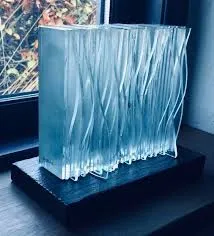Understanding Monolithic Annealed Glass An Overview
Monolithic annealed glass is a widely used material in construction and design, known for its versatility and cost-effectiveness. This type of glass is manufactured from a single layer of glass that has undergone a controlled heating and cooling process known as annealing, which enhances its strength and stability. In this article, we will explore the characteristics, manufacturing process, advantages, and applications of monolithic annealed glass.
Characteristics of Monolithic Annealed Glass
Monolithic annealed glass is typically clear but can also be produced in various colors and tints. It has a smooth surface and excellent optical clarity, making it suitable for applications where visibility is crucial. The thickness of monolithic glass can vary, commonly ranging from 3mm to 19mm, depending on its intended use.
One of the key physical properties of this glass is its ability to withstand thermal stress due to the annealing process. During manufacturing, the glass is heated to a temperature near its melting point and then gradually cooled. This process relieves internal stresses, making the glass less likely to break under typical temperature changes compared to non-annealed glass.
Manufacturing Process
The production of monolithic annealed glass begins with the melting of raw materials, primarily silica sand, soda ash, and limestone, in a furnace
. Once the glass is formed, it is shaped into sheets through a process known as float glass technology, where molten glass is floated on molten tin to create a flat, smooth surface.
After the glass is cut to the desired dimensions, it undergoes the annealing process. The cut glass sheets are placed in an annealing lehr, where they are heated to a high temperature and then slowly cooled. This controlled cooling is essential as it minimizes the risk of defects, such as warping or cracking, ensuring the final product is durable and reliable.
Advantages of Monolithic Annealed Glass
monolithic annealed glass
Monolithic annealed glass offers several advantages that contribute to its popularity in various industries. First and foremost, it is cost-effective compared to other types of glass, such as tempered or laminated glass. This makes it an attractive option for large-scale construction projects where budget constraints are a consideration.
Another significant advantage is its ease of handling. Monolithic annealed glass is lighter and easier to install than thicker laminated or tempered alternatives. This can lead to reduced labor costs and quicker installation times, making it a preferred choice for contractors and builders alike.
Additionally, the optical clarity of monolithic glass allows natural light to penetrate spaces, creating bright and welcoming environments. This characteristic is particularly valuable in residential and commercial buildings, where maximizing light can enhance the overall aesthetic and reduce the need for artificial lighting.
Applications
Monolithic annealed glass is employed in various applications, including windows, doors, and facades in residential and commercial buildings. It is also used in interior design elements, such as glass partitions, mirrors, and shower enclosures. In the automotive industry, annealed glass is commonly used for windshields and side windows due to its outstanding visibility and strength.
However, while monolithic annealed glass is suitable for many applications, it is essential to acknowledge its limitations. Unlike tempered glass, it does not possess high impact resistance, making it less suitable for areas prone to severe weather conditions or where safety is a concern. In such instances, alternative glass types, such as tempered or laminated glass, may be more appropriate.
Conclusion
In summary, monolithic annealed glass is a fundamental material in modern construction and design. Its unique properties, combined with cost-effectiveness and versatility, make it an ideal choice for a wide range of applications. As technology continues to advance, the future holds the promise of even more enhancements in the manufacturing and performance of this essential building material.
 Afrikaans
Afrikaans  Albanian
Albanian  Amharic
Amharic  Arabic
Arabic  Armenian
Armenian  Azerbaijani
Azerbaijani  Basque
Basque  Belarusian
Belarusian  Bengali
Bengali  Bosnian
Bosnian  Bulgarian
Bulgarian  Catalan
Catalan  Cebuano
Cebuano  Corsican
Corsican  Croatian
Croatian  Czech
Czech  Danish
Danish  Dutch
Dutch  English
English  Esperanto
Esperanto  Estonian
Estonian  Finnish
Finnish  French
French  Frisian
Frisian  Galician
Galician  Georgian
Georgian  German
German  Greek
Greek  Gujarati
Gujarati  Haitian Creole
Haitian Creole  hausa
hausa  hawaiian
hawaiian  Hebrew
Hebrew  Hindi
Hindi  Miao
Miao  Hungarian
Hungarian  Icelandic
Icelandic  igbo
igbo  Indonesian
Indonesian  irish
irish  Italian
Italian  Japanese
Japanese  Javanese
Javanese  Kannada
Kannada  kazakh
kazakh  Khmer
Khmer  Rwandese
Rwandese  Korean
Korean  Kurdish
Kurdish  Kyrgyz
Kyrgyz  Lao
Lao  Latin
Latin  Latvian
Latvian  Lithuanian
Lithuanian  Luxembourgish
Luxembourgish  Macedonian
Macedonian  Malgashi
Malgashi  Malay
Malay  Malayalam
Malayalam  Maltese
Maltese  Maori
Maori  Marathi
Marathi  Mongolian
Mongolian  Myanmar
Myanmar  Nepali
Nepali  Norwegian
Norwegian  Norwegian
Norwegian  Occitan
Occitan  Pashto
Pashto  Persian
Persian  Polish
Polish  Portuguese
Portuguese  Punjabi
Punjabi  Romanian
Romanian  Russian
Russian  Samoan
Samoan  Scottish Gaelic
Scottish Gaelic  Serbian
Serbian  Sesotho
Sesotho  Shona
Shona  Sindhi
Sindhi  Sinhala
Sinhala  Slovak
Slovak  Slovenian
Slovenian  Somali
Somali  Spanish
Spanish  Sundanese
Sundanese  Swahili
Swahili  Swedish
Swedish  Tagalog
Tagalog  Tajik
Tajik  Tamil
Tamil  Tatar
Tatar  Telugu
Telugu  Thai
Thai  Turkish
Turkish  Turkmen
Turkmen  Ukrainian
Ukrainian  Urdu
Urdu  Uighur
Uighur  Uzbek
Uzbek  Vietnamese
Vietnamese  Welsh
Welsh  Bantu
Bantu  Yiddish
Yiddish  Yoruba
Yoruba  Zulu
Zulu 

